2010 One-and-Dones: Was It Worth It?
Posted by rtmsf on July 22nd, 2010After another summer of loud belly-aching, moaning and groaning about how the NBA’s one-and-done rule is methodically destroying college basketball as we know it, we’re left with the fact that, in reality, only eleven players from the prep class of 2009 found their way into the 2010 NBA Draft pool. As it turns out, approximately 90% of the RSCI Top 100 players from last year’s freshman class will return to play another season of college basketball in 2010-11. And this is not unusual. In the four NBA Drafts where one-and-doners were forced to attend at least one year of college (2007-10), there have been a total of 35 such players, or around nine per season. There are obvious problems with the NBA’s one-year rule that we won’t get into here, but we shouldn’t be losing our heads over what amounts to a handful of players each season.
And what about those players — how did it go for them? We can safely presume that if you’re good enough to be one-and-done, a year in college probably worked out well enough for you (ahem, Tommy Mason-Griffin excepted). But we’re more interested in the schools. How did recruiting and ultimately matriculating a one-and-done player work out for those institutions? Put in real terms, was bringing a player like Derrick Favors on campus at Georgia Tech for one year worthwhile? What about Calipari’s den of young Cats? You may recall that we did this school-centric analysis in each of the last three summers (2007, 2008, and 2009), and the basic conclusion that we’ve found is that one-and-done players have generally benefited their schools in the two areas that matter most: 1) wins; and 2) marketability. Let’s take a closer look at this year’s group.
2010 One-and-Dones
Kentucky – Well Worth It. Say what you want about the meltdown of Calipari’s Cats in the Elite Eight against a tougher, more experienced West Virginia team, but the fact that Kentucky brought in the #1 recruiting class of 2009 and delivered on the implied promise that Cal’s system develops NBA draft picks is why his cadre of one-and-dones (John Wall, Eric Bledsoe, DeMarcus Cousins, Daniel Orton) was well worth it. And here’s the what behind the why: four five-star prospects arrive in Lexington next year (Enes Kanter, Brandon Knight, Doron Lamb, Terrence Jones) and two more are signed on for 2011 (Michael Gilchrist, Marquis Teague) with several others lurking in the wings. Not every one of these players will become a one-and-doner, so eventually Calipari will be able to season some experienced talent around his annual lottery pick arrivals (see: 2008 Memphis) to give himself a great chance to win that elusive national title. As far as the difference in Q rating from the Gillispie era to now, it’s like that $22M/year Tiger Woods lost in endorsements since last November somehow ended up in Lexington as gold-plated streets. UK has become the program du jour for the young, moneyed and hip, and when the head coach infamously stated that this year’s NBA Draft night was the greatest night in the history of Kentucky basketball, he’s referring to marketability. The pitch: come to Lexington, play a fun style of uptempo basketball, win 30-35 games, market your brand on television through our deals with CBS and ESPN, have a shot to win a title, meet celebrities such as LeBron James and Drake, and end up shaking David Stern’s hand in a year or two… not exactly fraught with hard decisions. If Calipari can keep his program in the headlines for the right reasons, this class will be looked at as the tipping point for a whole new era of Kentucky basketball. Definitely well worth it.
Marshall – Well Worth It. If you recruit a player who wasn’t even ranked in the RSCI top 100 and he ends up dominating your league as a freshman center to the point of becoming the Conference USA defensive POY and leading the nation in blocked shots, it was well worth it. Hassan Whiteside’s one year in Huntington led the Thundering Herd to its best season in over two decades, culminating in a fourth-place finish in CUSA, big late-season wins over UAB and Tulsa, and a quarterfinal appearance in the CIT. For a program that hasn’t been to the NCAAs since 1987, any postseason appearance is a great year, and Whiteside’s patrolling of the paint had no small part in it. The unfortunate part of Whiteside’s meteoric rise is that the Herd had such a good season that as a result it also lost its head coach Donnie Jones, which may impact the long-term marketability aspect of Whiteside’s year there. Nevertheless, we doubt anyone at Marshall regrets the year that both Whiteside and Jones resided in Huntington together, so we think that this was a huge boost for a mid-major program not used to having such players around.
Georgia Tech – Worth It. Paul Hewitt’s program has been burned by one-and-dones before, notably in 2007 when both Thaddeus Young and Javaris Crittenton led an inconsistent but very talented Yellow Jackets team to its last NCAA Tournament appearance prior to 2010. We said at the time that the loss of those two players could set back his program a spell, and indeed it took three years and the arrival of all-world prospect Derrick Favors to carry Tech back to the Dance (and presumably save Hewitt’s job for at least another year). Still, last year’s team was also inconsistent (an ugly hallmark of Hewitt’s) and short of a strong run to the ACC Tournament finals, the Jackets were not likely to have been Dancing. Favors had solid numbers (12/8/2 BPG), including 21/18 against Maryland and 22/11 against Duke, but there was a lingering sense that the athletic big man had not quite figured it all out just yet. This one is a very tough call, and it may change if the Tech program falls off again, but considering that GT had gone 27-36 (9-23 ACC) in the previous two seasons and they were a possession away from winning the ACC Tournament against the eventual national champs, we’re going to say that having Favors around for a single year was worth it (conditional on Hewitt continuing to turn things around in Atlanta).
Kansas – Worth It. On a team filled with offensive talent that many pundits, ourselves included, figured would cut down the nets in Indianapolis last year, it was the freshman Xavier Henry who often seemed the steady hand as some of his more experienced peers traded turns jacking up difficult shots (Sherron Collins) or hiding out underneath the basket (Cole Aldrich). Prior to the beginning of the season, we had serious concerns about comments made by Xavier and his father and, in particular, whether their seeming me-first attitude would negatively impact the loaded title contender. It didn’t. Rather, Henry seamlessly transitioned into Bill Self’s system by starting nearly every game on the wing and becoming the 33-win team’s second-leading scorer (taking and making mostly good shots). In our view, it turned a Jayhawk squad from a really good team into a great one (notwithstanding the Northern Iowa debacle), and it had the corollary effect of showing that Self can handle players with one-and-done aspirations (and difficult family members!) such as Henry. In fact, Self proved that he can showcase talent in a way that maximizes his team’s potential while also exhibiting that his coaching style isn’t as deliberate and fixed as some might argue. Therefore, we think that even though Kansas’ season didn’t end as many had expected, Henry’s one year in Lawrence was still worthwhile, as KU won games hand over fist and helped improve the marketability of the program.
Texas – Not Worth It. This is a hard one because we recognize that not every one-and-done will be a Kevin Durant or even a John Wall, but much more was expected from Avery Bradley (the top overall recruit by ESPNU) and his team last season. After a 17-0 start that had resulted in the Horns residing at the very top of the polls in mid-January, UT experienced a complete meltdown after they had seen their own blood. Texas went 7-10 the rest of the way, bowed out in ugly defeats to Baylor and Wake Forest in March, and turned what looked to be potentially their best season ever into an unmitigated disaster. Of course, the primary issue for Barnes’ team last season was spotty point guard play, and Bradley appeared to struggle to adjust to his role as a combo guard in the system. For example, he had more zero-assist games than five-plus ones, and he failed to hit a single three during the final four weeks of the season. We wondered aloud last year if Texas simply had too many chefs in the kitchen — what with J’Covan Brown, Dogus Balbay and Jordan Hamilton all vying for backcourt minutes — and not one of them exceptional at fulfilling the duties of a traditional point guard. The bottom line is this for Bradley: if Texas bounces back next season and the offense appears much more fluid, then his removal from Austin may be viewed by many as addition by subtraction. For that reason, we think that his one-and-done season wasn’t worth the headaches.
Cincinnati – Not Worth It. If you’re a program like Cincinnati trying to claw its way into the elite of the Big East standings for the first time, you expect that a top ten talent like Lance Stephenson will help get you there. Instead, we now know for a fact that Mick Cronin’s team was not markedly different that the one from the year before (a sub-.500 Big East team), and we’re not sure that Born Ready’s year in the Queen City improved the marketability of that program to where other top prospects will want to follow him there. There were always questions about his maturity and inability to make the simple pass rather than the spectacular one, but interestingly, when he told Cincinnati reporters that he was likely to stay in college for an additional year to work on his glaring weaknesses (such as his 22% conversion rate from beyond the arc), UC was going through a period of losing five of its last six regular season games. Ultimately, the Bearcats made it to the NIT and won a game before losing to regional rival Dayton, but it’s a significant difference from what UC fans were hoping for when Stephenson declared his intention to matriculate there last summer. With a fairly young team set to return next year, Mick Cronin, like Barnes above, may be hoping for an addition-by-subtraction scenario as well.
Oklahoma – Ridiculously Not Worth It. Where to begin with this mess? Not only was Oklahoma an absolute embarrassment to its brand with a team that basically quit halfway through the year (losing its last nine games), but the two players who were one-and-dones were more apt to be described as rats fleeing a sinking ship than stars moving on to greener pastures. Tiny Gallon and Tommy Mason-Griffin both had statistically solid freshman seasons, but neither wowed anyone to the point where they were considered legitimate pro candidates at this point. After the season, Gallon admitted to taking money while he was in high school, while Mason-Griffin foolishly stayed in the draft without apparent realization that 5’11 combo guards who shoot 40% from the field are in low demand at the next level. It was no secret that Mason-Griffin clashed with head coach Jeff Capel on occasion, but his smarter move would have been to transfer rather than become the first one-and-done prospect to go undrafted. Regardless of these two, OU is facing possible NCAA sanctions as a result of Gallon’s misdeed among other allegations, and the program is certainly in no better shape now that these two players (along with sophomore Willie Warren) are gone. You have to believe that Capel would take back the recruiting of these players if he could, because the resultant damage to the Sooner program is completely not worth it.
One-and-Dones: Historical Snapshot
With another year of evidence by which to assess the impact of one-and-done players on their schools, not much has changed. As we said last year, our qualitative analysis showed that 54% of one-and-dones (13 of 24) had been, at minimum, worthwhile to the school involved. With seven of this year’s eleven added to the total, we now find that 57% (20 of 35) were worthwhile recruits, and 60% of those players (12 of 20) were huge successes. This means that nearly a third of one-and-done players have been what we would describe as “well worth it” for his school, and more than half of all were worth the risk. Echoing the sentiment we outlined last season, the only conclusion that should be drawn from this, despite the paucity of Final Four appearances by one-and-doners, is that coaches who fail to recruit the very best talent are probably doing themselves a disservice. The objective of every major program is to make Final Fours and win national championships, but the journey to get there has to be built on a foundation of talent, and successful one-and-dones can pay dividends in terms of future talent well beyond the scope of their W/Ls while briefly on campus.





























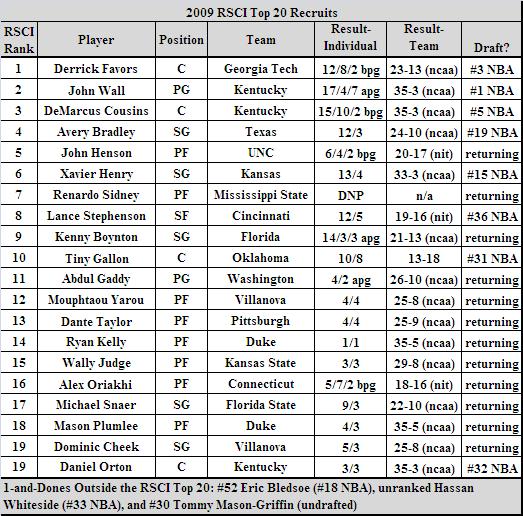
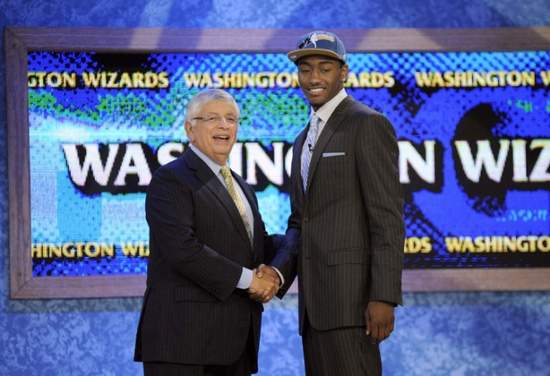
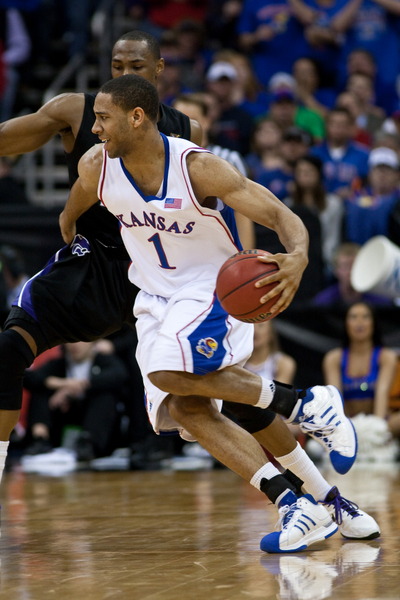
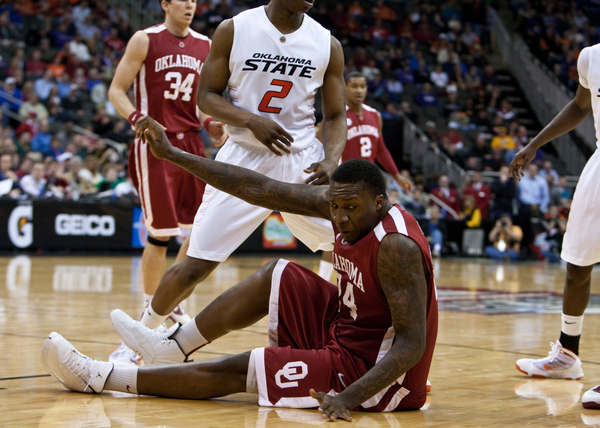
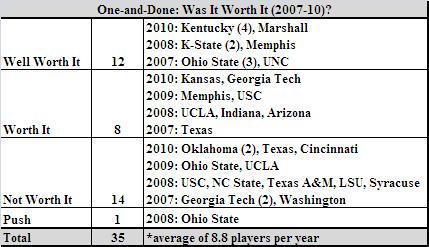














One thing missing from the discussion is Academic Progress Rate (APR). In the short-term, recruiting one-and-dones might be worthwhile, but it the long-run, if done consistency, won’t a college’s APR be damaged?
Bruno – good comment. I haven’t focused on that b/c there hasn’t been enough data to make determinations on that yet, but certainly a school like Kentucky with four 1-and-dones in a single year may need to worry about that in the future. Thanks.
What do people say is deliberate and fixed about Bill Selfs coaching? His offense?
I’ve honestly not heard this much, except from bitter Illinois fans that swear he only runs high low. At Kansas he’s always adapted his offense to the talent on his roster. When his best scoring options are in the post (Wayne Simien) he runs a lot of Hi Low, but other than that…most years he runs multiple different offensive sets or schemes that put his best offensive players in position to get good shots versus the defense that they’re playing. Thats why I think he’s a fantastic coach…he doesn’t have a set offense that’ he’ll never adjust from and the attitude that “we don’t adjust to you, you’re going to have to adjust to us”. His offense has set principles typically, but they run sets based on what they’re opponent does defensively. And throughout his career his teams following this approach have been wildly successful at all of his stops…espcecially KU.
His teams at Kansas have almost always been in the top 10 to 15 of offenisve efficiency. His best teams at KU (’10, ’08) were both #2 in KenPoms Offensive EFF ratings
Bill – no problem here with Self’s offense. We’re just heard that criticism before. Doesn’t mean it’s true.